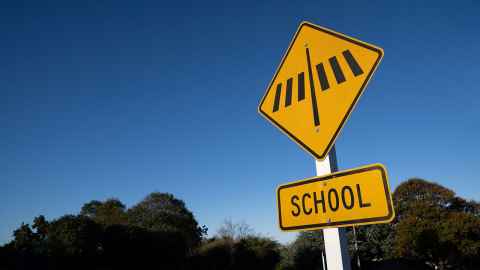Easing children back into school
15 November 2021
Opinion: This week, the priority in primary schools should be for children to catch up with relationships rather than catch up with school work, writes Peter O'Connor.

On Wednesday, primary schools will begin again to reverberate with the sounds of kids. They will be filled with laughter and joy at reconnecting after months of lockdown. But underpinning this excitement will be understandable fear and anxiety about the return.
It feels very different to last year when schools reopened, as Covid is in the community and we are all unsure as to what might happen next.
For many parents, teachers and children there will be justifiable anxiety too about what students have missed since they were last open. There have already been misguided and tone-deaf calls for schools to cram missed literacy and numeracy content into kids in the weeks before Christmas.
Research at the University of Auckland confirms that there are more important and useful things to do to help transition children back into school. We can learn from the extraordinary work done by schools in Canterbury following the earthquakes where a focus on wellbeing held whole communities together. We can also learn from what we did so successfully last year following lockdowns.
Last year a unique partnership between New Zealand Educational Institute, the New Zealand Principals’ Federation, the Sir John Kirwan Foundation and the University of Auckland worked together on a distinctly New Zealand way to return to school post crisis.
An online resource, called Te Rito Toi (www.teritotoi.org ) was created that provides lesson plans and advice for teachers to use the arts and creativity to help students reflect on their lockdown experiences and consider how they might use those experiences to make their learning more fruitful as they meet their teachers and classmates again.
The central pou of Te Rito Toi is that arts-informed curricular approaches are powerful for individual and community recovery after disaster, strengthening social support and building hope. For students, it is a gentle way back into schools that promotes opportunities to create and reflect on how the world has changed during lockdown. At its heart, it’s about children catching up with relationships before catching up with learning.
The programme is based on decades of international research into what the arts do, that they qualitatively shift the kinds of talk that happen in classrooms and provide students with opportunities to recognise how crises have disrupted their lives and schooling. It also provides creative processes for them to respond to their experiences as they re-join their school communities.
In 2020, the University of Auckland team carried out a research project with eight schools around Aotearoa about the use of Te Rito Toi in schools. It found the lockdowns were just another layer of trauma, with multiple traumas happening in the lives of children and their families; the pandemic just exacerbated what was already happening. This was especially true in areas where Covid hit hard and where there are existing traumas such as poverty and social dislocation.
When children are busy working hands-on in the arts, teachers observed it was easier to have meaningful one-on-one conversations about their worries and concerns. This research demonstrates that the arts provide a space for safe dialogue with the adult teachers about their anxieties such as “will my grandad die? What will happen if we get sick?” All the big questions that are best handled outside a whole class discussion can arise in these parallel conversations.
The research found coming back to school to some joy and fun, with the excitement of painting, drawing, dancing and moving was also critical in supporting student well-being. Many teachers in this study, recognising the trauma of transition, decided to put aside more formal learning structures to excite kids about being back at school.
Te Rito Toi has been used in 140 countries with nearly 400,000 downloads. The Te Rito Toi team has presented webinars with more than 40,000 teachers around the world that have inspired similar resources in Hong Kong, Taiwan and Canada.
The Ministry of Education has joined the Principals’ Federation, NZEI, and UNESCO New Zealand in endorsing the approach for schools in Auckland and Waikato when they physically reopen on Wednesday.
Schools won’t have the luxury of going back to normal. Nor should they go back as if nothing has happened. They must address with children the fact that the world has changed and help their students make sense of that change. Schools have a vital role in preparing children for the future of work, but they must also be about helping children make sense of their present lives and give them the tools to imagine a world different and better for others.
Parents should feel reassured the focus for schools next week will be on helping children to reflect on and create their own experiences in a safe way to make sense of how they might be feeling.
As our classrooms spring back to life they will shrug off the calls for more literacy and numeracy and instead embrace the opportunity to process, reflect and respond to the changing world around them rather than expecting them (and us) to just get on with it.
A webinar supported by NZEI, NZPF and the Sir John Kirwan Foundation can be joined on Wednesday November 17 at 4pm.
Professor Peter O’Connor is from the Faculty of Education and Social Work.
This article reflects the opinion of the author and not necessarily the views of the University of Auckland.
Used with permission from Newsroom Easing children back into school 15 November 2021.
Media queries
Alison Sims | Media adviser
DDI 09 923 4953
Mob 021 249 0089
Email alison.sims@auckland.ac.nz